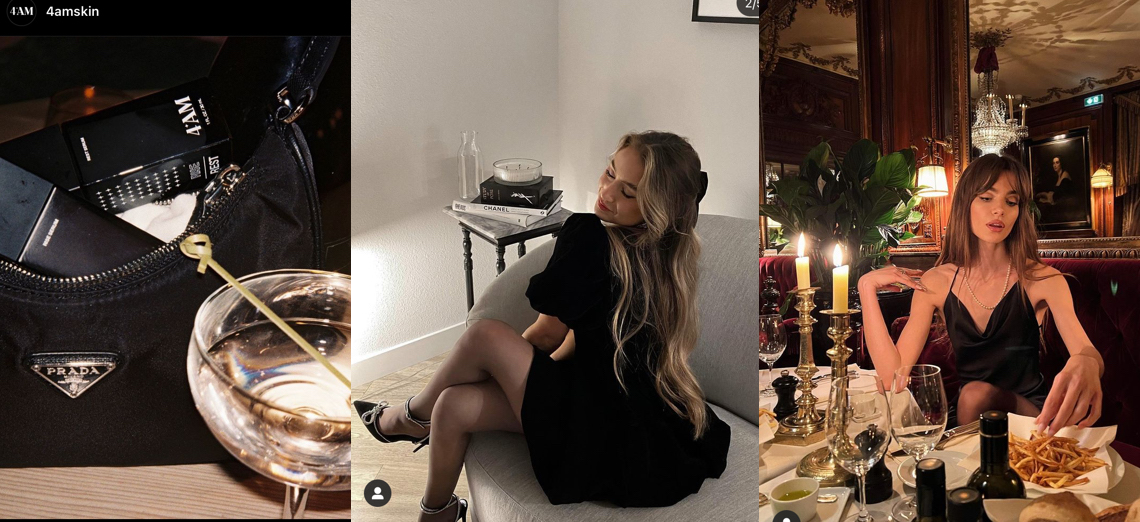While the pandemic isn’t “over,” the last year has undoubtedly seen progress toward some semblance of a return to “normalcy.” Big events like the Oscars and the Met Gala are happening again, and some workers are going back to the office. The opportunities to dress up now are a lot more common than they were in 2020.
But is the return to normal bringing with it a pent-up surge of interest in dressing up and high fashion, as many speculated? Are we actually entering a “Roaring Twenties” period of glitz and glamour coming back into style?
Exclusive data provided to Glossy by financial technology company Klarna shows a somewhat complicated answer to those questions. On the one hand, glamorous items like cocktail dresses and fake lashes surged in sales in the period between October 2021 and March 2022, but more comfortable WFH-friendly categories grew, as well. Meanwhile, sales of high heels and other types of dressy footwear were down.
In short, dressing up to go out is back, but so is staying comfortable and practicing self-care. Just as shoppers are spending more on evening gowns, they’re also spending more on comfortable pajamas. It’s a combination of the Roaring Twenties and the Snoring Twenties.
“As consumers make their way back to offices, events, concerts and traveling, their wardrobes are once again going through a transformation to refresh and reset for these new adventures,” said Raji Behal, head of U.S. partner success at Klarna. “We see this represented in Klarna’s data, which revealed an 86% increase in ball gowns [and other] clothes we never would have worn during stay-at-home conditions last year. We are also hearing this will be the biggest wedding year since 1984.”
In the period observed by Klarna between October and March, which it compared against the same six-month period from 2020 to 2021, sales of cocktail dresses through Klarna grew by nearly 400%, trouser suits for women were up by 96%, and there was a 229% increase in sales of palazzo, or wide-leg, trousers. Many of the products seeing growth would fit right in with the “night luxe” aesthetic, the celebration of nocturnal glamour.
In beauty, many of the most prominent categories also suggest a re-embrace of going out. Sales of blemish care and hair gel are both up more than 400%, fake lashes are up more than 2,000%, and curling wands are up 583%.
Ad position: web_incontent_pos1
At the same time, categories that suggest comfortable nights spent at home are still seeing growth, as well. Sleepwear is up 348%, for example. In beauty, face care is up 7,533%, and bath oil is up 2,897%.
Possibly the most interesting trends, though, are those suggesting a hybrid of the two emerging lifestyles. Products that let one go back out into the world while keeping some of the comfort that consumers have become used to make up some of the highest-growth categories in Klarna’s data. It shouldn’t be too surprising. The actual Roaring Twenties in the 20th century also combined glamour with comfort, seeing the rise of the loose-fitting flapper dress over the more restrictive corsets of previous decades.
While uncomfortable high heels and wedges are down 26% and 48%, respectively, more comfortable but still stylish gladiator sandals are up 114%. Skorts also grew by 44% and coveralls grew by 116%.
The emphasis on comfort is something brands have noticed, and you can see the influence that’s had on their designs. Suit brands, for example, have gravitated toward more breathable fabrics. Athletic brands, meanwhile, have taken the opportunity to introduce more office-friendly clothing like polo shirts using the same performance materials as their other products.
“If there’s one trend here to stay for a long time as a result of the pandemic, it’s a higher priority and appreciation for comfort and wellness,” Behal said. “While consumers are excited to mix up their wardrobes and get back out into the world, they want to combine style with comfort to do so.”




